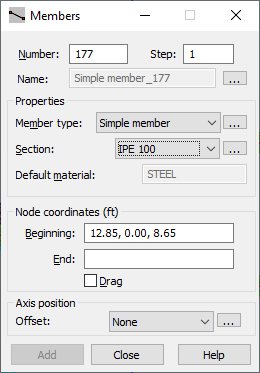Open the Members dialog, which lets you define member elements within structures, using any of the following methods:
- Click Geometry menu > Members.
- Click
 .
.
- the MEMBER layout (you can select layouts from the selection list on the Standard toolbar).

The method for defining a member depends on the mode of the cursor. Depending on its type, options shown in the dialog permit:
- Dragging to grid mode (snap=grid) - Defines the coordinate grid points (analogous to snap-free mode)
- Dragging to already existing structure points or nodes (snap=node) - Defines the point or node numbers
- Dragging to already existing lines (snap=line) - Defines the line number.
Also, you can define the following member properties:
- Member type
- Member cross section
In addition, the default material is displayed for the selected member.
The Name field displays the name according to the syntax selected in the Names of Members/Objects dialog. By default, the name of a member is defined by the variables: %t_%n and %t_%s, where:
%t - Name of the member type
%n - Object number
%s - Section name.
Clicking
![]() opens the Names of Members/Objects dialog, which lets you define a new syntax for names.
opens the Names of Members/Objects dialog, which lets you define a new syntax for names.
Axis position lets you select an offset, that is, the displacement of the center of the cross-section with respect to the member axis. After you assign an offset to a member, it is not modified after changing the section of the member.
You can select Upper flange or Lower flange offsets. For example, if you select upper flange, the member axis is shifted towards the center of the upper edge of the section, regardless of the cross-section type defined for the member. Clicking
![]() opens the New Offset dialog, where you can define a new offset type to add to the active list.
opens the New Offset dialog, where you can define a new offset type to add to the active list.
You can define a member element using any of the following methods:
- Enter the member number and the coordinates of its beginning and end in the dialog or select member properties and click Add.
- Click Beginning in the dialog, and move the cursor to the graphic screen, and click the point depicting the beginning of the member element and then the endpoint.
- Use a method which uses a combination of the methods above.
See also:
